The demographics, according to Livi-Bacci (1993)1, is studying the processes that determine the formation, preservation and disappearance of the populations. These processes are: fertility, mortality and mobility. The multiple combinations of these phenomena, interdependent among themselves, determines the speed of the changes of the population, both in its dimensions-numerical, as in its structure. The demography is very closely linked to the biological (fertility and mortality are considered before anything else biological processes, since humans are mammals, the factor biogenético influences the reproductive capacity as well as in longevity), and social (processes related to the forms of organization of human beings; so, for example, the mortality and its intensity according to age and sex are conditioned by different types of habits: type of food, access to health care, hygiene, cultural and religious factors, etc).
As the same Livi-Bacci says: “there is, between the natural factors and social on the one hand and demographic phenomena on the other, a reciprocal interaction that is not limited to the effects of the former over the latter, but also, although with a different intensity, is given in reverse”. While it is true, it is much more obvious the influence of the demographic phenomena on the social. The study of demographic phenomena and social interdependence has been known recently as a socio.
The two major theories that have been developed in demography is the Theory of the Demographic Transition and Second Demographic Transition. But it does not seem to have been enough for most of the social sciences is taken seriously, the demographics with the ability of being able to describe and analyze the major social transformation that humanity experienced in its entire history.
Recently, a group of researchers has proposed a unifying theoretical framework of the two demographic transitions linked to population change and social modernization. This is the Theory of the Reproductive Revolution. One of those researchers who want to introduce you to today’s couple the section of Sociology in a Network in this blog: Julio Pérez Díaz.

Julio Pérez Díaz, is part of the project of the TRR (Theory of the Reproductive Revolution), a project which has been intensely working for the demographics, using the most appropriate tools, should be capable of generating an explanatory framework of their own which, to give an account of how certain improvements of survival can be amplified, between a few generations and the next, and how the increased reproductive efficiency resulting becomes in itself a trigger of subsequent improvements, dragging on the process to all of the behaviors and human characteristics involved in social reproduction (gender, cohabitation, family, work, education, etc).
Julio Pérez Díaz is a graduate in Philosophy, doctor in Sociology and senior demographer researcher of the Centro Superior de Investigaciones Científicas (CSIC) in the Institute of Economics, Geography and Demography of the Centre of Human and Social Sciences. He is a specialist in demographic ageing, population policy and methodology of demographic analysis. His main line of research are sociodemographic changes in a global world.
For his numerous contributions in a selfless manner, valuable information in your field of study and research, very useful for the theory and sociology of the population so that sociology is concerned, it was essential to include in my section on Sociology Network to Julio Perez and his brilliant blog Notes of demography. As he says himself, he believes in “the transformative power of the internet as a tool to democratize access to knowledge”.
.

In his blog Notes from the demographics we can find many teaching resources, discussions, exercises solved of demographic analysis, a complete section on the ageing of the population and the other on population policies, academic activities, and informative. All free-form and free.
.
Ruben Crespo
on April 24, 2012NOTES
- Livi Bacci, M., & González López, M. (1993). Introduction to demography. Editorial Ariel, SA [↩]
